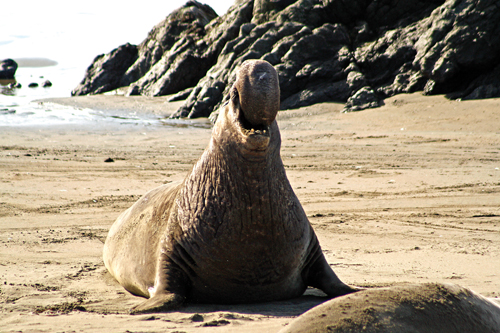
An Apha male elephant seal dominates his space at the rookery near the Piedras Blancas Lighthouse.
– The California Department of Parks and Recreation and the National Oceanic and Atmospheric Administration are urging the public to view northern elephant seals from a safe distance, especially during the upcoming mating and pupping season of December through March.
Once nearly extinct, these elephant seals have made a dramatic recovery over the last century bounding back from less than a 100 to an estimated 210,000 – 239,000 animals. The rookery of elephant seals at Piedras Blancas has recently become one of the largest on the west coast of the United States with an estimated population of 23,320.
But as their numbers increase, so has the potential for humans to interact intentionally or unintentionally with these animals. Despite their sometimes docile and clumsy appearance, elephant seals can be extremely quick and sometimes vicious if humans, or their pets, get too close.
In addition, all marine mammals, like elephant seals, are protected under federal law and anyone harassing these animals by getting too close may be subject to prosecution under the Marine Mammal Protection Act. To report violations, call State Parks Dispatch at (805) 927-2068.
- If you see an injured animal, stay back and call the Marine Mammal Center at (805) 771-8300 or (415) 289-7325.
- To assist the public in safely viewing these animals, the following viewing guidelines are provided:
- Watch quietly from a safe distance of at least 100 feet – remember wild animals are unpredictable.Use binoculars and spotting scopes.
- Use binoculars and spotting scopes.If a seal becomes alert or nervous and begins to move away, you are too close.
- If a seal becomes alert or nervous and begins to move away, you are too close.
- Dogs and seals don’t mix. Dogs should be on a leash no longer than 6 ft. and 100 ft. away from any seal.
- Observe beach closures and restrictions.
The best place to view seals from a close, yet safe distance is at the Elephant Seal board walk or vista points 3 and 4, which are 4.5 miles or 7.2 km west of Hearst Castle Visitors Center on Highway 1.
For more information on northern elephant seals, please visit:
California Department of Parks and Recreation: http://www.parks.ca.gov/?page_id=26424
Friends of the Elephant Seal: http://www.elephantseal.org/
NOAA: http://www.nmfs.noaa.gov/pr/species/mammals/pinnipeds/northernelephantseal.htm
Monterey Bay National Marine Sanctuary Public Service Announcement: https://www.youtube.com/watch?v=_oZFH6AsDS8











